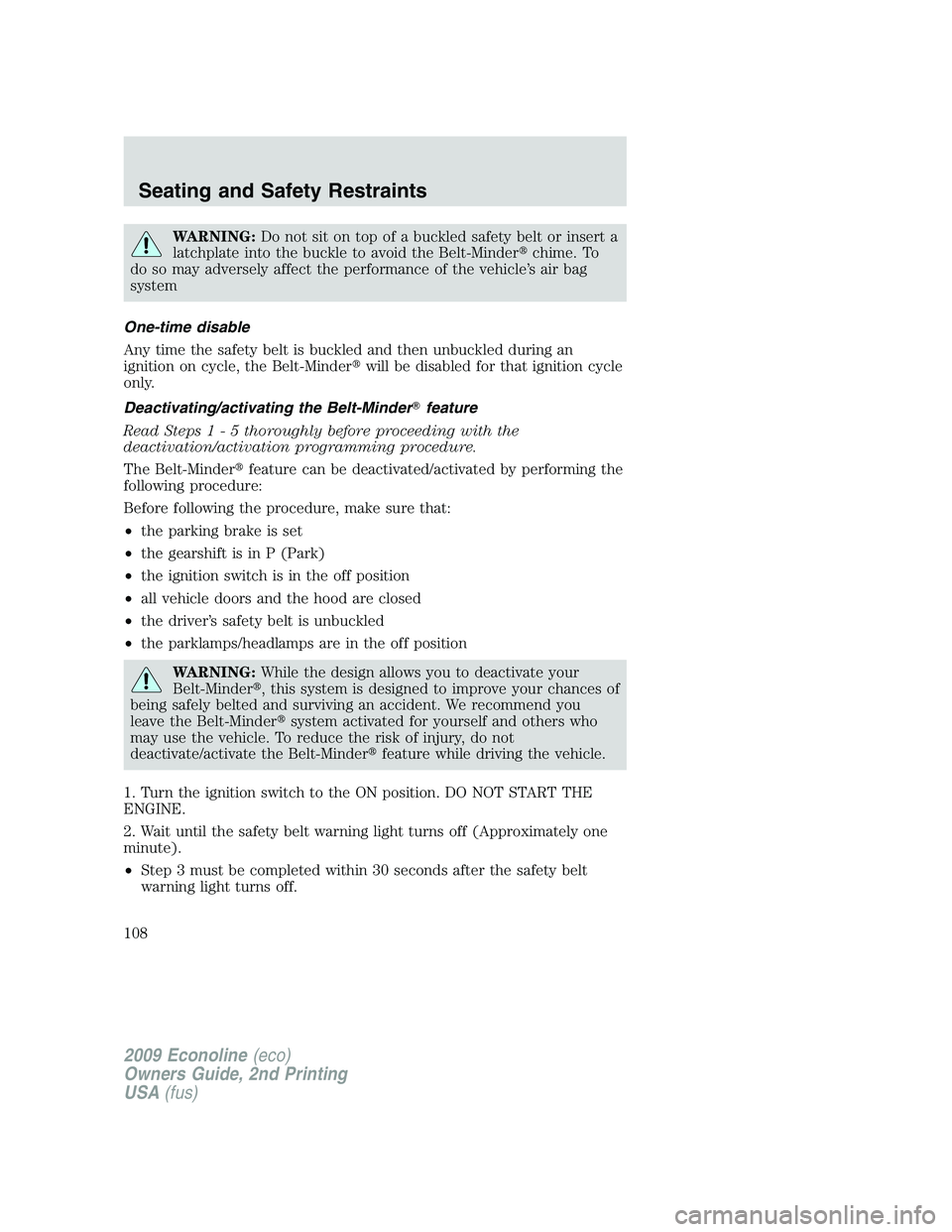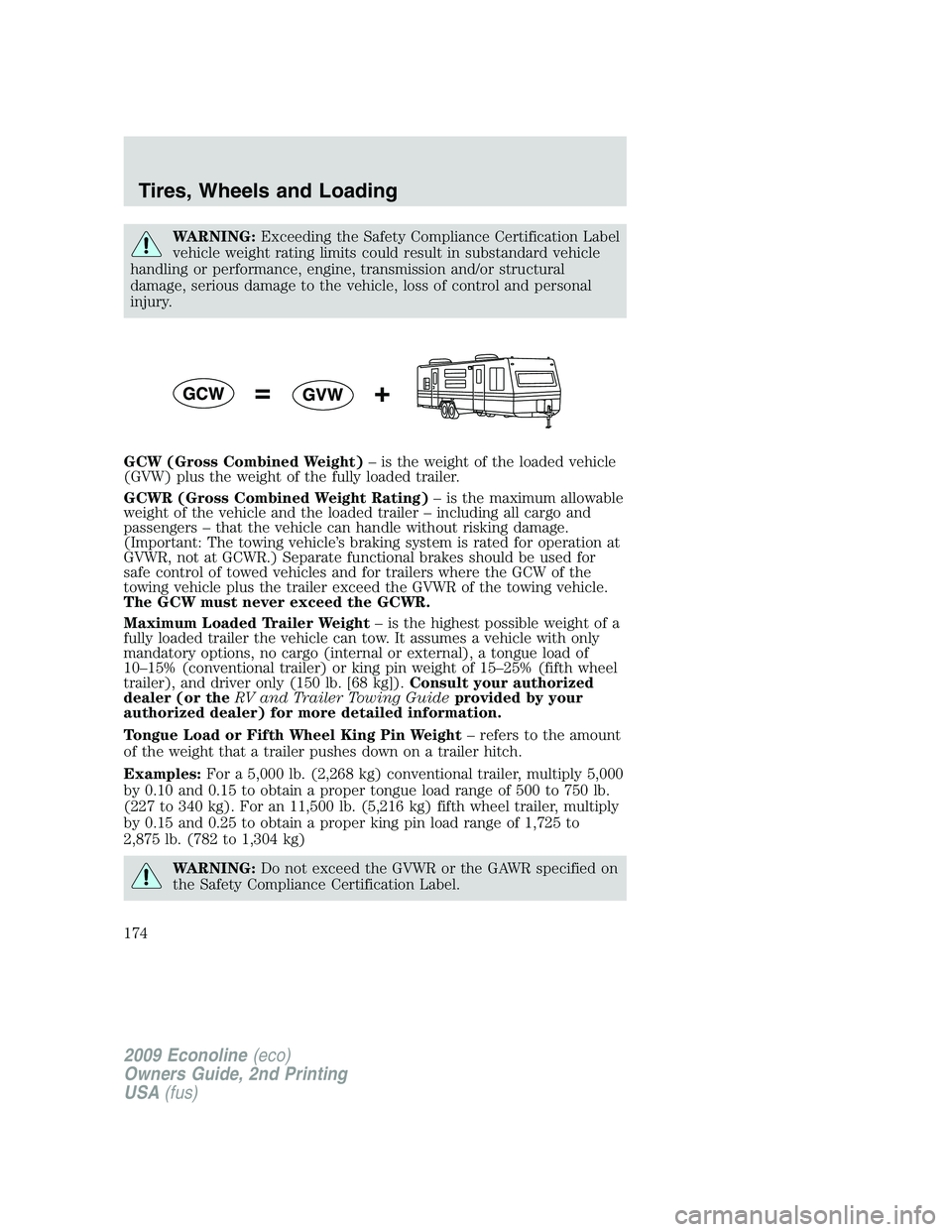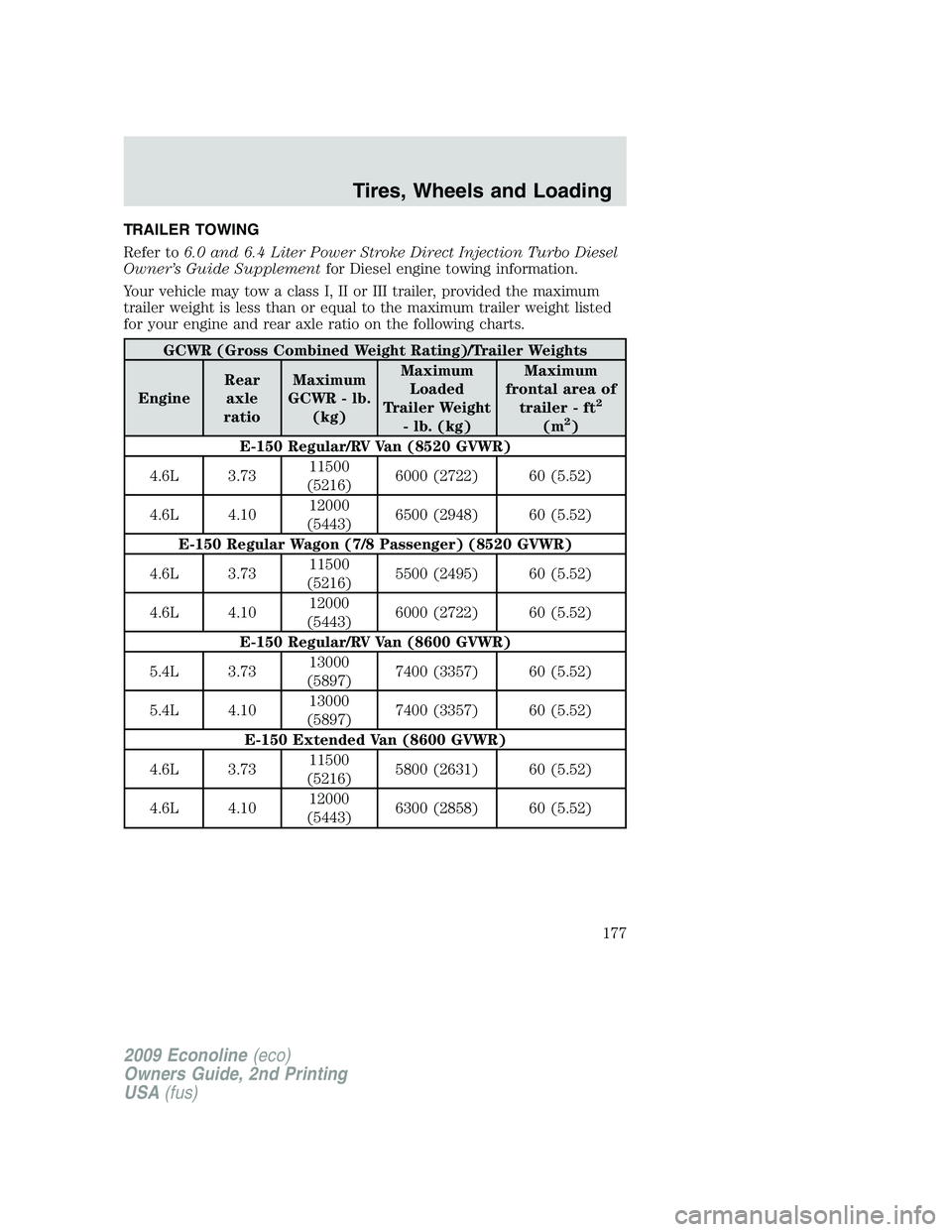Page 91 of 320
5. Within 10 seconds of removing the secondcoded key,insert the new
unprogrammed key (new key/valet key) into the ignition and turn the
ignition from the 3 (off) position to the 4 (on) position (maintain ignition
in the 4 (on) position for at least one second, but no more than
10 seconds). This step will program your new key to a coded key.
6. To program additional new unprogrammed key(s), repeat Steps 1
through 5.
If successful, the new coded key(s) will start the vehicle’s engine and the
theft indicator will illuminate for three seconds and then go out.
If not successful, the new coded key(s) will not start the vehicle’s engine
and the theft indicator will flash on and off and you may repeat Steps 1
through 5. If failure repeats, bring your vehicle to your authorized dealer
to have the new spare key(s) programmed.
2009 Econoline(eco)
Owners Guide, 2nd Printing
USA(fus)
Locks and Security
91
Page 108 of 320

WARNING:Do not sit on top of a buckled safety belt or insert a
latchplate into the buckle to avoid the Belt-Minder�chime. To
do so may adversely affect the performance of the vehicle’s air bag
system
One-time disable
Any time the safety belt is buckled and then unbuckled during an
ignition on cycle, the Belt-Minder�will be disabled for that ignition cycle
only.
Deactivating/activating the Belt-Minder�feature
Read Steps1-5thoroughly before proceeding with the
deactivation/activation programming procedure.
The Belt-Minder�feature can be deactivated/activated by performing the
following procedure:
Before following the procedure, make sure that:
•the parking brake is set
•the gearshift is in P (Park)
•the ignition switch is in the off position
•all vehicle doors and the hood are closed
•the driver’s safety belt is unbuckled
•the parklamps/headlamps are in the off position
WARNING:While the design allows you to deactivate your
Belt-Minder�, this system is designed to improve your chances of
being safely belted and surviving an accident. We recommend you
leave the Belt-Minder�system activated for yourself and others who
may use the vehicle. To reduce the risk of injury, do not
deactivate/activate the Belt-Minder�feature while driving the vehicle.
1. Turn the ignition switch to the ON position. DO NOT START THE
ENGINE.
2. Wait until the safety belt warning light turns off (Approximately one
minute).
•Step 3 must be completed within 30 seconds after the safety belt
warning light turns off.
2009 Econoline(eco)
Owners Guide, 2nd Printing
USA(fus)
Seating and Safety Restraints
108
Page 166 of 320
TPMS reset procedure
It is recommended that you read the entire procedure before attempting.
Note:To enter the reset mode, Steps 1–6 MUST be completed within
60 seconds.
1. Place the ignition in the off position and keep the key in the ignition.
2. Press and release the brake
pedal.
3. Cycle the ignition from off to on
three (3) times ending in the on
position—DO NOTstart the engine.
4. Press and hold the brake pedal
for two (2) seconds, then release.
2009 Econoline(eco)
Owners Guide, 2nd Printing
USA(fus)
Tires, Wheels and Loading
166
Page 167 of 320
5. Turn the ignition to off—DO
NOTremove the key.
6. Cycle the ignition from off to on three (3) times ending in on.DO
NOTstart the engine.
If the reset mode has been entered successfully, the horn will sound
once, the TPMS indicator
will flash and the message center will
displayTRAIN LEFT FRONT TIRE.
If after repeated attempts to enter the reset mode, the horn does not
sound, the TPMS indicator
does not flash and the message center
does not displayTRAIN LEFT FRONT TIRE, contact your authorized
dealer as soon as possible.
7. Train the TPMS sensors in the tires using the following TPMS reset
sequence starting with theleft front tirein the following clockwise
order:
2009 Econoline(eco)
Owners Guide, 2nd Printing
USA(fus)
Tires, Wheels and Loading
167
Page 174 of 320

WARNING:Exceeding the Safety Compliance Certification Label
vehicle weight rating limits could result in substandard vehicle
handling or performance, engine, transmission and/or structural
damage, serious damage to the vehicle, loss of control and personal
injury.
GCW (Gross Combined Weight)– is the weight of the loaded vehicle
(GVW) plus the weight of the fully loaded trailer.
GCWR (Gross Combined Weight Rating)– is the maximum allowable
weight of the vehicle and the loaded trailer – including all cargo and
passengers – that the vehicle can handle without risking damage.
(Important: The towing vehicle’s braking system is rated for operation at
GVWR, not at GCWR.) Separate functional brakes should be used for
safe control of towed vehicles and for trailers where the GCW of the
towing vehicle plus the trailer exceed the GVWR of the towing vehicle.
The GCW must never exceed the GCWR.
Maximum Loaded Trailer Weight– is the highest possible weight of a
fully loaded trailer the vehicle can tow. It assumes a vehicle with only
mandatory options, no cargo (internal or external), a tongue load of
10–15% (conventional trailer) or king pin weight of 15–25% (fifth wheel
trailer), and driver only (150 lb. [68 kg]).Consult your authorized
dealer (or theRV and Trailer Towing Guideprovided by your
authorized dealer) for more detailed information.
Tongue Load or Fifth Wheel King Pin Weight– refers to the amount
of the weight that a trailer pushes down on a trailer hitch.
Examples:For a 5,000 lb. (2,268 kg) conventional trailer, multiply 5,000
by 0.10 and 0.15 to obtain a proper tongue load range of 500 to 750 lb.
(227 to 340 kg). For an 11,500 lb. (5,216 kg) fifth wheel trailer, multiply
by 0.15 and 0.25 to obtain a proper king pin load range of 1,725 to
2,875 lb. (782 to 1,304 kg)
WARNING:Do not exceed the GVWR or the GAWR specified on
the Safety Compliance Certification Label.
2009 Econoline(eco)
Owners Guide, 2nd Printing
USA(fus)
Tires, Wheels and Loading
174
Page 177 of 320

TRAILER TOWING
Refer to6.0 and 6.4 Liter Power Stroke Direct Injection Turbo Diesel
Owner’s Guide Supplementfor Diesel engine towing information.
Your vehicle may tow a class I, II or III trailer, provided the maximum
trailer weight is less than or equal to the maximum trailer weight listed
for your engine and rear axle ratio on the following charts.
GCWR (Gross Combined Weight Rating)/Trailer Weights
EngineRear
axle
ratioMaximum
GCWR - lb.
(kg)Maximum
Loaded
Trailer Weight
- lb. (kg)Maximum
frontal area of
trailer - ft
2
(m2)
E-150 Regular/RV Van (8520 GVWR)
4.6L 3.7311500
(5216)6000 (2722) 60 (5.52)
4.6L 4.1012000
(5443)6500 (2948) 60 (5.52)
E-150 Regular Wagon (7/8 Passenger) (8520 GVWR)
4.6L 3.7311500
(5216)5500 (2495) 60 (5.52)
4.6L 4.1012000
(5443)6000 (2722) 60 (5.52)
E-150 Regular/RV Van (8600 GVWR)
5.4L 3.7313000
(5897)7400 (3357) 60 (5.52)
5.4L 4.1013000
(5897)7400 (3357) 60 (5.52)
E-150 Extended Van (8600 GVWR)
4.6L 3.7311500
(5216)5800 (2631) 60 (5.52)
4.6L 4.1012000
(5443)6300 (2858) 60 (5.52)
2009 Econoline(eco)
Owners Guide, 2nd Printing
USA(fus)
Tires, Wheels and Loading
177
Page 178 of 320
GCWR (Gross Combined Weight Rating)/Trailer Weights
EngineRear
axle
ratioMaximum
GCWR - lb.
(kg)Maximum
Loaded
Trailer Weight
- lb. (kg)Maximum
frontal area of
trailer - ft
2
(m2)
E-150 Extended Van (8600 GVWR)
5.4L 3.7313000
(5897)7300 (3311) 60 (5.52)
5.4L 4.1013000
(5897)7300 (3311) 60 (5.52)
E-150 Regular Wagon (7/8 Passenger) (8600 GVWR)
5.4L 3.7313000
(5897)7000 (3175) 60 (5.52)
5.4L 4.1013000
(5897)7000 (3175) 60 (5.52)
E-250 Regular/RV Van (8900 GVWR)
4.6L 3.7311500
(5216)5900 (2676) 60 (5.52)
4.6L 4.1012000
(5443)6400 (2903) 60 (5.52)
E-250 Extended/RV Van (8900 GVWR)
4.6L 3.7311500
(5216)5800 (2631) 60 (5.52)
4.6L 4.1012000
(5443)6300 (2858) 60 (5.52)
E-250 Regular/RV Van (9000 GVWR)
5.4L 3.7313000
(5896)7400 (3357) 60 (5.52)
5.4L 4.1013000
(5896)7400 (3357) 60 (5.52)
E-250 Cutaway (138” wheelbase, single rear wheel) (8600
GVWR)
4.6L 4.1012000
(5443)7500 (3402) 60 (5.52)
2009 Econoline(eco)
Owners Guide, 2nd Printing
USA(fus)
Tires, Wheels and Loading
178
Page 179 of 320
GCWR (Gross Combined Weight Rating)/Trailer Weights
EngineRear
axle
ratioMaximum
GCWR - lb.
(kg)Maximum
Loaded
Trailer Weight
- lb. (kg)Maximum
frontal area of
trailer - ft
2
(m2)
E-250 Extended/RV Van (9000 GVWR)
5.4L 3.7313000
(5896)7300 (3311) 60 (5.52)
5.4L 4.1013000
(5896)7300 (3311) 60 (5.52)
E-350 Regular/RV Van (9500 GVWR)
5.4L 3.7313000
(5897)7300 (3311) 60 (5.52)
5.4L 4.1013000
(5897)7300 (3311) 60 (5.52)
6.8L 3.7315000
(6804)9100 (4128) 60 (5.52)
6.8L 4.1018500
(8391)10000 (4536) 60 (5.52)
E-350 Extended/RV Van (9500 GVWR)
5.4L 3.7313000
(5897)7200 (3266) 60 (5.52)
5.4L 4.1013000
(5897)7200 (3266) 60 (5.52)
6.8L 3.7315000
(6804)9000 (4082) 60 (5.52)
6.8L 4.1018500
(8391)10000 (4536) 60 (5.52)
E-350 Regular Wagon (11/12 Passenger) (8800 GVWR)
5.4L 3.7313000
(5897)6700 (3039) 60 (5.52)
5.4L 4.1013000
(5897)6700 (3039) 60 (5.52)
2009 Econoline(eco)
Owners Guide, 2nd Printing
USA(fus)
Tires, Wheels and Loading
179